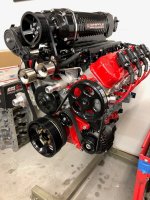Some, Sleeving can be tricky, I now only use a Block out of a SS Blazer, the 6.2 is the worst to sleeve very thin on the aluminum sides, most likely to keep the heat down, and the LS2 block have had a 50% success rate, so when sleeving is sonic wall test each block after the sleeve are out, can take a little time,
If someone wants a RHS Block, and is a Member that is almost the same price as a sleeved block after Sleeves, Good Block Line Hone, Decking, Cleaning Clearance for crank ect,
I dont think anyone can beat my price in a RHS block for Members only,
And a RHS is a priority main oiling system, this means it will feed the crank and rods before the lifters,
My 2 cents
Yup - the days of cheap used LS blocks are gone and with everyone wanting to go Big Inch (for good reasons) Aftermerket is smart. Not really cheaper or the same price in reality doing it right - sorry Jason ...
And there are some downsides of the RHS Aluminum block to be fair in certain applications - while they are mostly superior to all the factory blocks if for the only reason of having a Longer sleeve and allowing bigger cubic inch without excessive oil consumption and increased piston skirt wear (rocking at the bottom) and they also have better material sleeves and the aforementioned priority oiling (copied from the GM LSX iron block).
They are not guaranteed to handle more HP than factory aluminum, and they do have issues
Especially on SC engines of ripping out the front main because there is not enough material for the main studs to grab - they tried to make the block breath a little better ( LS's all have windage issues except the LS Next block) and it weakened that area,
Like everything there is no one size fits all
I recommend the CP Performance tall Block for Large inch SC engines - its basically a copy of the LSX block in Aluminum with more meat down the Main area - not that we have seen no problems with all aftermarket blocks. Just choose the right block for the application - its not one size fits all.
In fact if you want to go max Effort you have to go Iron - where that HP falls is really open to discussion, and where and how you drive and car weight etc. but the general consensus unless you like to rip the engine down every season is 1440 HP - which is just under the theoretical limit of an e85 using boosted engine
But that assumes you keep the RPM redline under 7200 and set it closer to 6800 and stay off the limiter.
You can do an aluminum enginme with 1800+HP on M1 and e85 but be prepared to rip it down and swap bearings and rings at least once a season
On SC engines if you want cubes (and you should) a tall deck lets you run a 4" or 4 .125 stroke and get to 454 or 468 without the risk of breaking off a crank snout which is common with 4.250 stroke and SC's especially those big Whipples I would never go over 4" stroke with them, there is a graveyard of broken s=crank snouts due to that,
Once again smart builds are important - so many time experience is key.
Turbo cars are easier on the crank but harder on the rods and get into detonation quickly, there are ways we get around that without killing power on SC and Turbo cars but its more cost in the build
RPM kills engines and NA's need RPM to make power, so realistically you will spend more on parts on the long block for a High HP NA vs an SC or Turbo making more power . boosted engines don't need to RPM that high, so we build them different . Big inch NA needs really big heads and big valves to make power you need to get fuel in instead of anBoosted where it gets pushed in and NA needs big exhaust to get it out too - heads are expensive and heads those big valves need bigger springs that are prone to getting hot and failing and need bigger heavier push rods and more expensive rockers and lifters and better cam cores to keep it all working smooth with less valve train oscillation, you might even need a solid cam and you don't want to go there. - so the cam choice is key and its really hard to make low end power - so you are never enjoying a smooth cruise - i hate compromises so I give up a bit on the top to get way more in the mid - many dyno tests to get a good combo - and we don't drive dynos so lots of seat of the pants too, to get a good combo you will spend good $$
Boosted engines don't need all they heavy expensive heads and parts its a waste for the most part, you save money there and improve reliability as well. And yes you can make 1200+ HP on a set of under $1000 heads in a boosted configuration.
it should be noted that None of the aftermarket blocks are ready to use out of the box if you do it right ... I spend a full day deburring them before even starting on machine work, they also require some special parts in most cases like front ancd rear covers in the case of tall blocks different timing chains and plugs and gaskets . I would say from experience of myself and machinist is that prepping an aftermarket block costs far more than factory and if it does not you should question the builder.
In 90+% of cases there is no way I would not do a tall block if I was going aftermarket - why not? we don't have to fit the engine under a hood ... and you get the advantage of running a non stroker compromised piston - so no issues with excessive oil consumption and piston rocking - you get to go bigger safely
You are buying a rotating assy anyway just go for tall deck parts. NA tall decks can easily go 500+ cubic inches - it makes that 900HP NA engine a reality. Just need really big heads liker Frankies' or better yet All Pros.
I hate the idea that you need to go through a HP engine every couple seasons like I am seeing more and more. I have done a number of 850-1,000 HP at the crank engines that have 10 seasons or more on them and they just run with oil changes and no issues ( the older 383 SC's smoke a little when you get on them hard after 5 seasons of so - just the stroker issue with short sleeves)
I guess my bottom line is that I like to big engines that are as reliable as those basically stock LS1's we see in 2005- 2008 ERA scand cars that in may cases are stilling running those same engines with just oil changes almost 20 years (seasons) later
FWIW



